Abstract
Cement mortar is made of a combination of cement, sand, and water, mixed in the right proportions. It is ideal for erecting walls and masonry structures, including those that must bear heavy loads. In addition, it is used in places that are exposed to higher humidity and in facilities located below ground level. The potential uses of a mortar are determined by material modification. The aim of the experimental studies was to evaluate the effect of high temperature on the microstructure and mechanical properties of cement mortars modified with polypropylene fiber. The novelty of this study is an attempt to compare the use of different types of polypropylene fibers in mortars heated at different temperatures. Cement mortars based on Portland cement CEM I 42.5 R with a constant content of three types of fibers in the amount of 0.9 kg/m3 were designed. The samples were cured and then heated in an oven at 300, 500 and 700 °C. The functional properties of cement mortars, i.e., density, flexural and compressive strength after 28 and 56 days of maturation, as well as flexural and compressive strength at elevated temperature, were determined using samples of 40 × 40 × 160 mm. By modifying cement mortars with fibers, it is possible to obtain a cement composite with good strength parameters which is, at the same time, resistant to high temperature.
1. Introduction
In accordance with the adopted principles of sustainable development, low-emission and energy-intensive, environmentally friendly technologies and materials should be used, and waste should be managed. According to Plastics Europe (Association of Plastics Producers in Europe) and EPRO (European Association of Plastics Recycling and Recovery Organizations), in 2018, the global production of plastics and plastic products was 2.5% higher than in the previous year and exceeded 368 million tons. 61.8 million tons, then decreased in 2019 to 57.9 million tons, i.e., by 6.3%. The demand of the European market for polymers in 2019 amounted to a total of 50.7 million tons, which is slightly lower than in 2018 (51.4 million tons). Although the role of the EU in the global plastics market is decreasing due to the strengthening of the position of Asian countries, led by China (China’s share in the global production of polymers in 2019 reached 31%, i.e., 114 million t), Europe still has a significant share in the global market of 16% (59 million tons). The strength of the European market is mainly determined by the demand for polymers and plastic products reported by six countries—with Germany playing the dominant role with 24% market share. Poland, with a demand of 3.55 million tons (7% share in the European market), is ranked sixth—behind Germany, Italy, France, Spain and Great Britain [1].
Cement composites are commonly used construction materials all over the world due to their many undeniable advantages, primarily high compressive strength, fire resistance, low cost of operation and speed of construction. The functional properties of cement mortars are based on the specific proportions of the binder, fine aggregate and water. Their high compressive strength means that they are used as a binder in the joints of two structural elements (brick with brick). Their limitations, however, result from brittleness and easy cracking due to low tensile strength, shrinkage and poor impact resistance [2]. This material is unsuitable for some industrial construction projects that require greater adhesion and strength. Despite these disadvantages, the demand of users is growing, which forces the continuous development of technology and production of mortars [3]. A common method of modifying a cement mortar is the use of a polymer additive in the form of water colloidal suspensions—Styrene-butadiene rubber (SBR) and Styrene-acrylic ester copolymer latex (SAE). Mortars modified in this way are used to repair mortars or renovate floor tiles. Another common way of strengthening cement mortar is to add various fibers to their masses. The main purpose of using the fibers is to control cracks during the loading stage. Compared to steel and carbon-glass fibers, polymer fibers are attractive due to their high ductility, which affects the flexural strength of cement-based materials.
Cement mortar is a material similar to concrete that allows for waste disposal [4,5,6,7,8,9,10,11,12,13]. This is important in the case of hardly degradable or non-biodegradable materials, which include polymers. Polymer materials have been used in concrete technology as a substitute for cement [14,15,16] and aggregates [17,18] as additives in the form of polypropylene fibers [19,20,21].
The superior binding properties of fiber-reinforced cement mortars make them suitable for repairs of existing structures, but also for newly built elements [22,23,24].
The fibers used to strengthen mortars are most often made of coal, glass, basalt steel and polypropylene [25,26,27,28].
Polyamide (PA) and polypropylene (PP) fibers are successfully used in cement composites to improve hardness and impact resistance, control shrinkage cracking and significantly increase the energy absorption capacity of the material [29,30,31].
Habib et al. [32] conducted research to determine the effect of synthetic fibers (glass, nylon and polypropylene) on the mechanical properties of mortars. Such industrial plastic fibers can offer better mechanical performance than recycled plastics.
Szwabowski et al. [33] prepared a standard cement mortar with the addition of the following fibers: fibrillated polypropylene, single polypropylene, steel, glass and pitch-type carbon fibres. As a result of the tests carried out on a fresh cement mortar, it was found that mortars with the addition of fibers, compared to the reference mortar, showed worse workability. The deterioration of workability in the case of single, carbon and glass polypropylene fibers is caused primarily by the increase in the volume fraction of fibers in the mortar. Mortars with the addition of fibrillated steel and polypropylene fibers have the least impact on the deterioration of mortar workability.
Ezerskiy et al. [34] used cements of various classes to produce cement mortars. It was found that samples made of cement with a higher strength class significantly increased the strength of the mortar by up to 30%. Therefore, a question arises regarding the economics of using fibers, perhaps it will be more economical and effective to use cement with an increased strength class than using additives in the form of fibers [34].
The subject of the influence of high temperature on strength was discussed by Drzymała et al. [35], who found that polypropylene fibers cause an increase in bending strength in the case of high temperature; an increase in temperature to about 300 °C reduces the amount of moisture, resulting in an increase in bending strength. The exposure to temperatures of 500–600 °C destroys the reference samples, while samples with the addition of polypropylene fibers retain residual strength.
A literature analysis shows that polypropylene fibers are widely used in fiber-reinforced concrete and HPC concrete. The fibers bear the tensile stress, reduce the shrinkage deformation of the cement matrix and prevent the formation of cracks and fissures. In the case of concrete, the fibers also increase the strength of the concrete. Research carried out to date has shown that the use of polypropylene fibers (3) in concrete can reduce the phenomenon of explosive spalling of concrete linings, also known as spalling. In the event of a fire, the polypropylene fibers melt, leaving an open pore network that allows water vapor to escape, reducing its pressure, and the internal stress does not exceed the limit. However, all presented studies dealt with concrete. It is not clear from the literature on this topic what effect polypropylene fibers have on thermally stressed cement mortars and how the type of fibers used affects the behavior of these mortars.
The aim of the research work was to determine the effect of elevated temperatures on the strength properties of cement mortars reinforced with polypropylene fiber or polymer fiber. The annealing temperatures of the samples were selected to correspond to the conditions prevailing at different stages of fire in buildings. The temperatures selected for the tests are characterized by characteristic points where structural changes in mortars may occur. The tests were aimed at determining the effect of the fibers used in mortars on their flexural and compressive strength in normal conditions and after initial thermal loading. The annealing of the samples was carried out in accordance with the adopted temperature distribution curve, similar to the so-called standard curve used to test the fire resistance of objects.
2. Materials and Methods
2.1. Cement Mortar
The cement mortar samples for testing were prepared on the basis of Portland cement CEM I 42.5 with high early strength R (Cement Ożarów SA, Ożarów, Poland), which meets the requirements of EN 197-1:2012 [36] and PN-B-19707:2023-05 [37], CEN standard sand with a grain size of 0–2 mm (Kwarcmix, Tomaszów Mazowiecki, Poland), water and an additive in the form of polypropylene fibers and polymer fibers (Steel Poland Factory SC, Jaworzyna Śląska, Poland). The parameters of Portland cement are presented in Table 1. These values are average values guaranteed by the manufacturer for 2022. CEN sand has a certificate of compliance with PN EN 196-1:2016-07 [38]. The sand grains are rounded, the mass content of silicon dioxide (SiO2) is 98%. The size distribution of standard sand was carried out by sieve analysis on a sample weighing 1350 ± g—Table 2. The temperature of the batches during the measurements was 20 ± 2 °C. The mortars were not modified in terms of the w/c ratio, which was constant and amounted to 0.5 [36,37,38].

Table 1.
Mechanical, chemical, and physical parameters of cement [39].

Table 2.
Size distribution of standard sand grains [40].
As part of the existing experimental work, two types of samples were prepared to determine the effect of the fiber additive on the flexural and wall strength:
- CEM I, CEM II (without additive): reference mortar;
- CEM II 1, CEM II 2, CEM II 3 (with additive): mortar with the addition of fibers in the amount of 0.5% of the weight of the cement.
The recipes had the same composition of cement, aggregate and water, they differed only in the type of fibers introduced—Table 3.

Table 3.
Concrete mix proportions by weight.
Samples with dimensions of 40 × 40 × 160 mm were prepared for testing. The samples were cured under standard conditions for 24 h, and after removal from the mold, they were marked and stored in water at 20 ± 2 °C.
2.2. Fibers
CH2(CH)3, bundled and cut—Figure 1, compliant with EN 14889-2:2007 (Bautech Sp. z o.o., Piaseczno near Warsaw, Poland) were used for the tests [41]. In the mortar, they form a three-dimensional load-bearing network, resistant to gravity, thanks to which the mortar maintains a constant level, cracks are prevented and plastic shrinkage and the formation of shrinkage cracks are reduced. An additional advantage of the fibers is the ability to mitigate the explosive tendencies of the mortar during fire—the fibers melting lower the pressure of the volatile substances. The sinusoidal shape of macro-synthetic fibers allows for strong anchoring in the mortar, provides protection against cracks, eliminating the risk of corrosion, and provides adhesion.
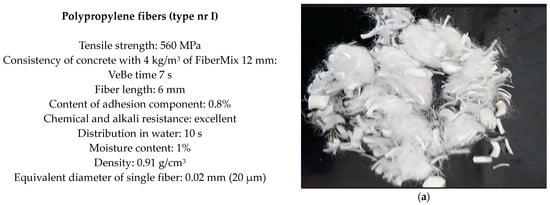
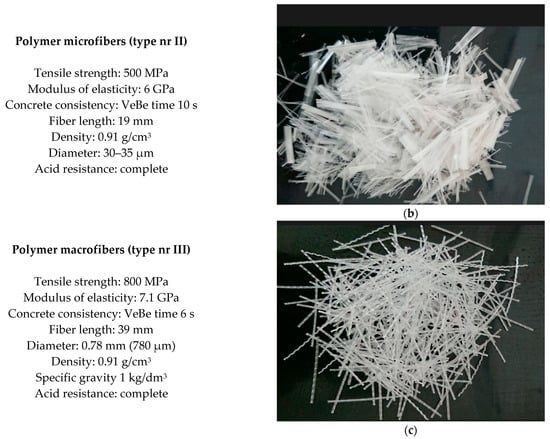
Figure 1.
Characteristics of fibers [42]: (a) Polypropylene fibers; (b) Polymer microfibers; (c) Polymer macrofibers.
2.3. Methodology of Testing
The prepared cement mortar was tested for consistency according to EN 1015-3:2000 [43] and bulk density according to PN-EN 1015-6:2000 [44]. To assess the influence of the type of fibers on the properties of cement mortars produced with their participation, the bending strength (fcf) and compressive strength (fc) were tested in accordance with the EN 196-1:2016-07 standard [36,43,44,45]. The Controls Advantest 9 hydraulic press (Controls, Warsaw, Poland) was used for the tests. The test was carried out on samples of 40 × 40 × 160 mm, with a sample size of 5 samples for each series. The beams were subjected to bending with increasing load until failure. A single-point load scheme was adopted—Figure 2. The beam halves formed after the test were used to perform the compressive strength test.
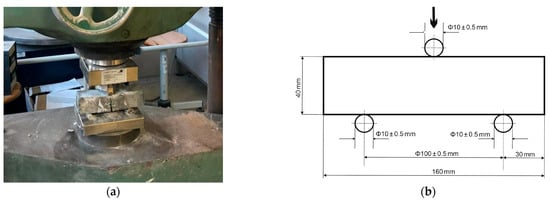
Figure 2.
Flexural strength tests: (a) Sample under test; (b) Schematic of the sample.
The resistance of cement mortars to high temperature was carried out in a PK 1100/5 furnace (Termolab SC, Warsaw, Poland) with electrically powered heating sections. The test was carried out in accordance with PN-EN 1363-1:2020-07 [46] at the temperatures of 20, 300, 500 and 700 °C—Figure 3. During the tests, the aim was to ensure that the temperature distribution over time was close to the conditions corresponding to a real fire. All prepared samples were dried to a constant weight at 105 ± 5 °C before starting the annealing. The signal from the thermocouples was recorded by a computer equipped with dedicated software [47].
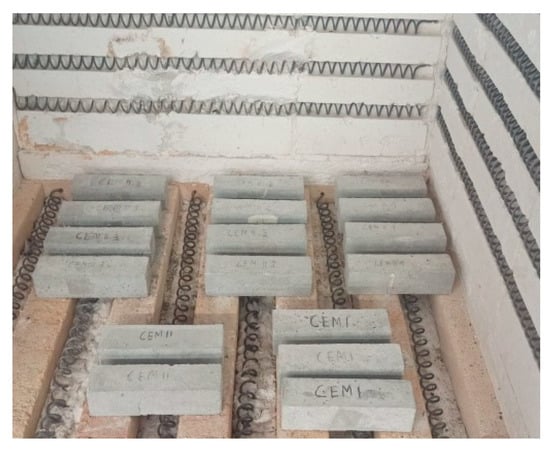
Figure 3.
Annealing furnace annealed samples.
The analysis and assessment of the effect of high temperature on the cement mortars was carried out omitting the cooling phase in a specific period. After reaching the appropriate temperature, i.e., 20, 300, 500 and 700 °C, the samples were heated for 30 min. This was to equalize the temperature in the entire volume of the element, and then it was freely cooled to ambient temperature. The total times of loading the composite with the temperatures of 300, 500 and 700 °C were 60, 120 and 180 min, respectively, for individual mortars.
2.4. Statistical Methods
After collecting the data for statistical analysis, statistical analysis was performed using Statistica 14 software (TIBCO Software Inc., Palo Alto, CA, USA) to identify selected characteristics of the variables. For the analyzed variables (strength/temperature), selected descriptive statistics were calculated—Table 4, including mean results, standard deviation, asymmetry and kurtosis coefficient (with appropriate standard errors) for all cases.

Table 4.
List of selected descriptive statistics.
The arithmetic mean is an estimator of the expected value in the population, for which the level of variable temperature for the study group is similar for bending and compression at 20 and 300 °C and is approximately 7 and 40 MPa, respectively. We observe a weak concentration of results around the mean for compression (kurtosis is below 0). There are many extreme results that are far from the average; the value of kurtosis for bending at 20 and 300 °C is above 0, which means that the number of such observations is decreasing.
3. Results and Discussion
3.1. Consistency
Based on the tests carried out on fresh cement mortar, it was found that the fibers affect its parameters—consistency and density. The reference cement mortar based on CEM I obtained a spread of 14.3 cm. The largest spreading diameter equal to 15.2 cm was obtained by the CEM II mortar, the smallest equal to 8.0 cm by the CEM II 3 mortar. The results for the CEM II 1 and CEM II 2 mortars are 15.0 cm and 11.0 cm, respectively. The highest bulk density equal to 2.28 g/cm3 was obtained by the mortars CEM II 1 and CEM II 2, the lowest equal to 2.15 g/cm3 by the reference mortar. Fiber parameters such as type, length, shape and their content in the cement matrix significantly affect the consistency, but its density to a lesser extent—Figure 4 and Figure 5.
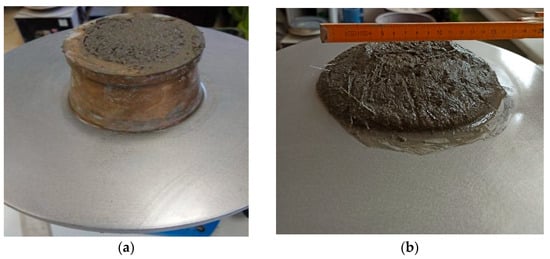
Figure 4.
Consistency testing for mortar with polymeric microfiber CEM II 3: (a) mortar in a cone; (b) mortar flow.
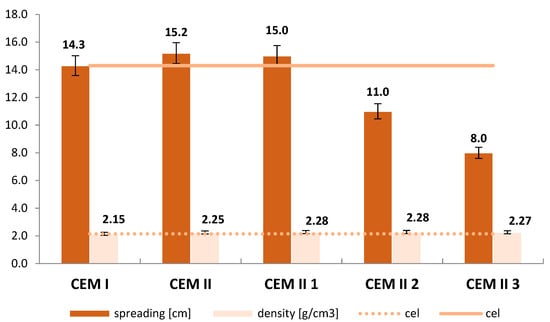
Figure 5.
Consistency and density of cement mortars.
3.2. Compressive and Bending Strength
The flexural strength was checked in two periods of maturation after 28 and 56 days on the trabeculae. The samples were subjected to a bending moment in the three-point bending scheme—Figure 6. During the test, the samples were set in such a way that their formulation surface was perpendicular to the direction of load application. The cement mortar halves formed during the test were used to determine the average compressive strength—Figure 7.
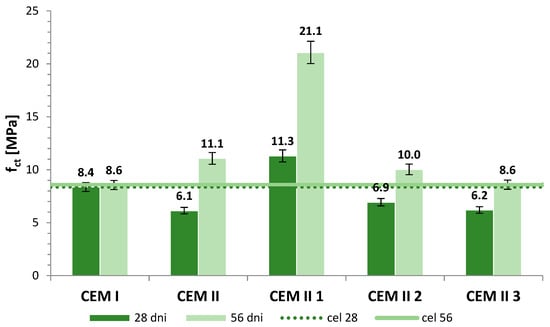
Figure 6.
Flexural strength after 28 and 56 days of maturing at 20 °C.
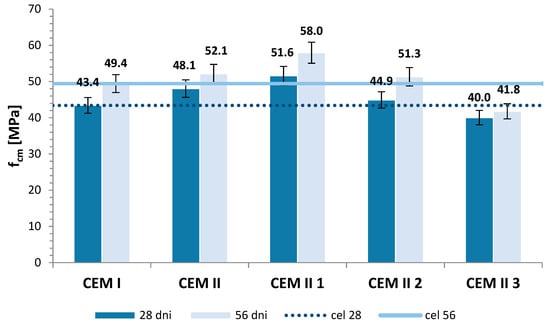
Figure 7.
Compressive strength after 28 and 56 days of maturing at 20 °C.
After the tests, a positive effect of polypropylene (1) and polymer (2) fibers on the compressive strength of cement mortars was observed. The highest strength in the first period of the measurement was 51.6 MPa for the CEM II 1 mortar, the smallest was 40.0 MPa for the CEM II 3 mortar. Samples of mortars made based on CEM II cement without additives obtained a strength higher by 10% than the standard one, while the CEM II 2 samples showed a strength higher by only 3% compared to CEM I. In the second period of curing, after 56 days, the highest compressive strength was 58.0 MPa, obtained by mortar CEM II 1, while the smallest amount was 41.8 MPa for mortar CEM II 3—similar to the first measurement. Compared to the reference mortar, the increase was 17%, while the decrease was 15%.
The increase in flexural strength in selected cases was also confirmed in the latest studies [48]. The strength of samples containing 0.15% of the volume increased by as much as about 40% in relation to the control samples. With a higher fiber content, however, a decrease in strength was observed. Regarding the compressive strength after 28 days, slight decreases were found, which increase with the fiber content. With an amount of 0.25% by volume, the compressive strength drops by as much as 36% compared to control samples. Additionally, an earlier study by Habib et al. [32] and Chen et al. [49] showed that adding PPF to cement mortar can increase the compressive strength. However, Feng et al. [50] concluded that adding too much PPF may reduce the compressive strength, but in general, the availability of polymers in a cement mortar plays an important role in increasing both its compressive and flexural strength. In these studies, attention was also paid to the length of polypropylene fibers. By stating that much better strength results are obtained in the case of long fibers dosed in the amount of 0.6 kg/m3.
3.3. Influence of High Temperature on Strength
Figure 8 shows the results of bending strength tests. The results are the arithmetic mean of five measurements. The bar halves obtained after the flexural strength test were used to determine the average compressive strength of 10 measurements. The results are shown in Figure 9. Error bars with a value of 5% are marked on the bar graphs.
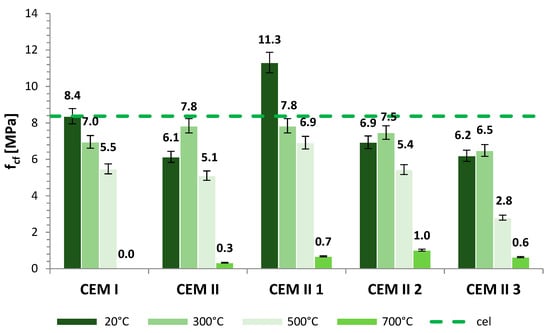
Figure 8.
Flexural strength for individual temperatures.
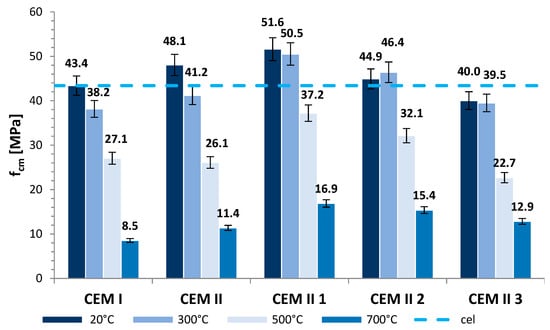
Figure 9.
Compressive strength for individual temperatures.
The analysis of the results of the tests on the impact of CEM I cement substitutes and fiber additive on the flexural strength showed differences between the tested variants. Mortars based on CEM II were characterized by an increase in flexural strength for the temperature of 300 and 700 °C, by 11% and 30%, respectively. By introducing polypropylene 1 and polymer 2 fibers into individual mortars, an increase in strength was observed for each firing temperature. Different results were observed for mortars with polymer fibers 3; the strength for each variant is lower than the strength of the reference mortar.
The analysis of the test results of the effect of CEM I cement substitutes and the addition of fibers on the flexural strength showed differences between the tested variants. Mortars based on CEM II were characterized by an increase in flexural strength for the temperature of 300 and 700 °C, by 11% and 30%, respectively. By introducing polypropylene 1 and polymer 2 fibers into individual mortars, an increase in strength was observed for each firing temperature. Different results were observed for mortars with polymer fibers 3; the strength for each variant is lower than the strength of the reference mortar.
It was observed that the use of CEM II cement and fibers had a positive effect on the increase in compressive strength for the CEM II, CEM II 1 and CEM II 2 samples. Comparing the obtained results of mortars with the addition of standard mortar, the best results were recorded for the mortar made with CEM II cement and polymer fibers 2. Mortar with polymer fibers showed a decrease in compressive strength.
Importantly, during the tests of samples with fibers, their explosive destruction (spalling) did not occur, thus avoiding the phenomenon of the coupled thermo-hydro-chemo-mechanical mechanism described, among others, in [51]. The confirmation of the beneficial effect of PPF fibers on the phenomenon of spalling was confirmed in several publications [52,53]. Polypropylene fibers, in addition to strengthening the structure of the cement matrix, are also used to limit the explosive behavior of concrete because of high temperature. These fibers melt at a temperature of about 170 °C, i.e., at a temperature lower than the maximum water vapor pressure in concrete, which is about 220 °C. After melting, polypropylene is partially or completely absorbed by the cement matrix, which results in the formation of evenly distributed voids throughout the structure, constituting the internal volume for the increasing water vapor pressure. At 350 °C, polypropylene burns into CO2 and H2O.
Polypropylene fibers are also used to increase the high temperature resistance of concrete (300–400 °C). The fibers prevent the phenomenon of peeling (breaking) from occurring. Concrete fragments rapidly disintegrate (sink) at high temperatures (in the event of a fire), exposing the reinforcement and thus causing a loss of the load-bearing capacity of the reinforced concrete member.
The beneficial properties of using PPF fibers in mortars subjected to thermal loads have also been demonstrated in [54]. In tests carried out at temperatures up to 1000 °C with a fiber content of 0.2%, during the compressive strength tests, a residual strength greater by 19% was obtained in relation to the control mortar without fibers. However, in [55], it was shown that the increase in residual strength can be obtained by hybrid use of polypropylene and basalt fibers in amounts of 0.1 and 0.2%. When the samples are loaded with a temperature of 200 °C, the residual compressive and bending strength increases by about 20%.
3.4. Test Results of the Structure and Composition of the Samples
The highest compressive strengths were obtained in a series of samples containing polypropylene fibers (CEM II 1 series) and this series of samples was selected for the structure tests. Polypropylene fibers 6 mm long and 20 μm in diameter were used (Figure 10).
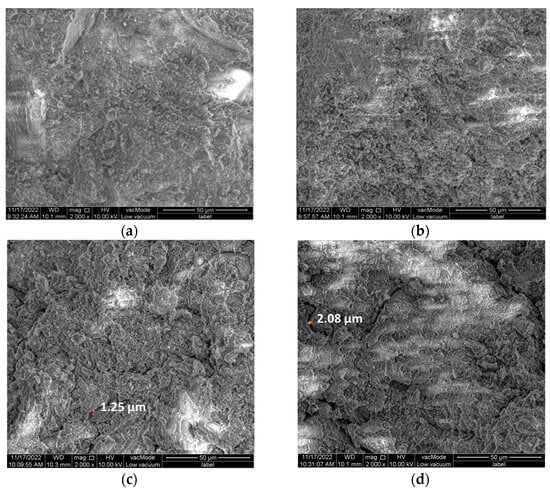
Figure 10.
SEM photographs of fractures of concrete samples of the CEM II 1 series (magnification 2000×): (a) base sample (20 °C); (b) sample heated at 300 °C; (c) sample heated at 500 °C; (d) sample heated at 700 °C.
Samples with the largest fiber dimensions (CEM II 3 series) were selected for the study of composition differences. The series contained polymer fibers with a length of 39 mm and a diameter of 780 μm. To determine the differences in the elemental composition of concrete samples (especially in the binder and places where the fiber and binder meet) caused by the temperature of their annealing (for temperatures of 20, 300, 500 and 700 °C), scanning electron microscopy SEM (FEI Quanta 3D FEG scanning electron microscope) with additional equipment was used m in the form of an EDS microanalyzer. The software allows for the automatic determination of the elemental composition of samples and can create profiles that determine the oxide content of elements.
Figure 11, Figure 12, Figure 13 and Figure 14 shows a SEM photograph containing breakthroughs of the base sample and samples annealed at 300, 500 and 700 °C (CEM II 1 sample series).
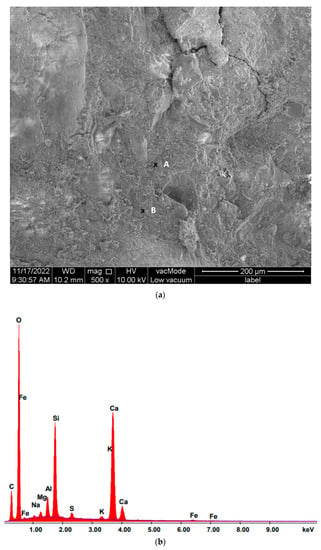
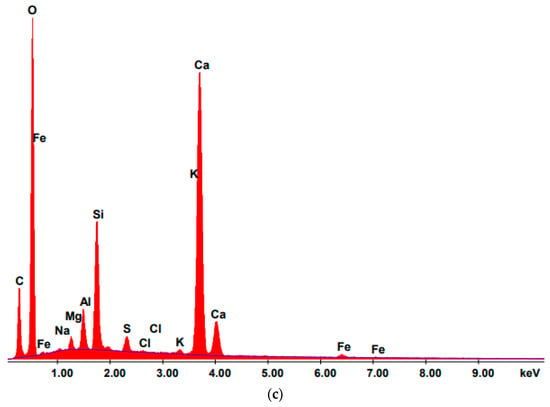
Figure 11.
Base sample (20 °C): (a) SEM photograph with points A and B marked; (b) the results of the EDS microanalysis of the sample point A; (c) the results of the EDS microanalysis of point B of the sample.
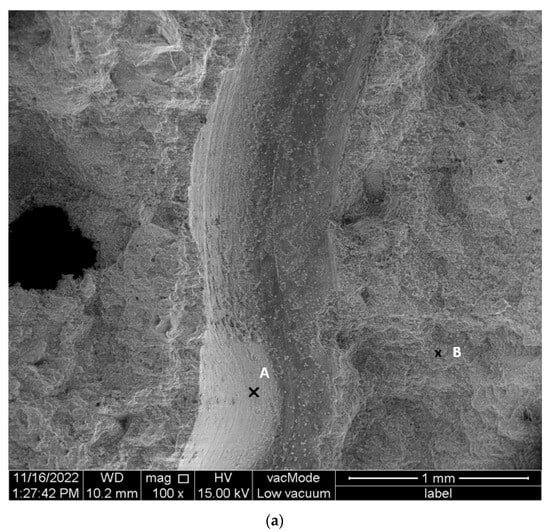
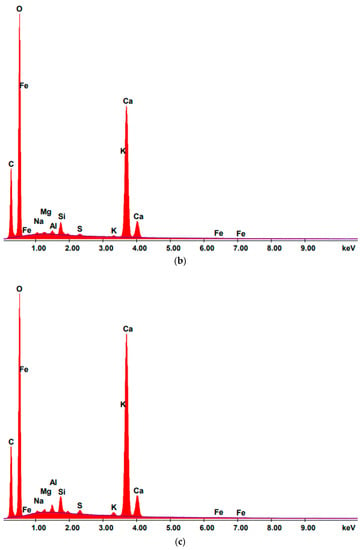
Figure 12.
Base sample (300 °C): (a) SEM photograph with points A and B marked; (b) results of the EDS microanalysis of the sample point A; (c) results of EDS microanalysis of sample point B.
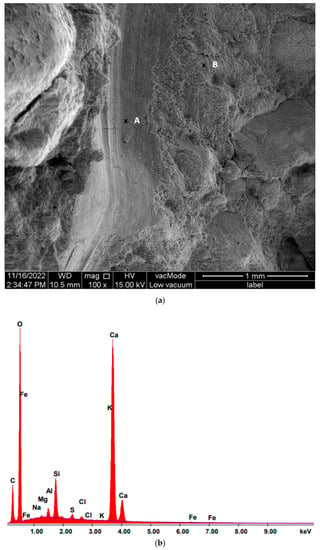
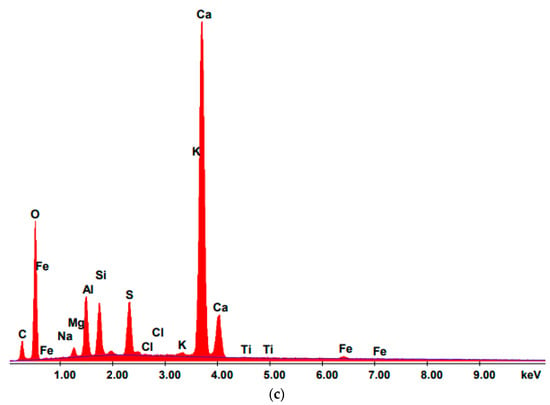
Figure 13.
Base sample (500 °C): (a) SEM photograph with points A and B marked; (b) the results of the EDS microanalysis of the sample point A; (c) the results of the EDS microanalysis of the sample point B.
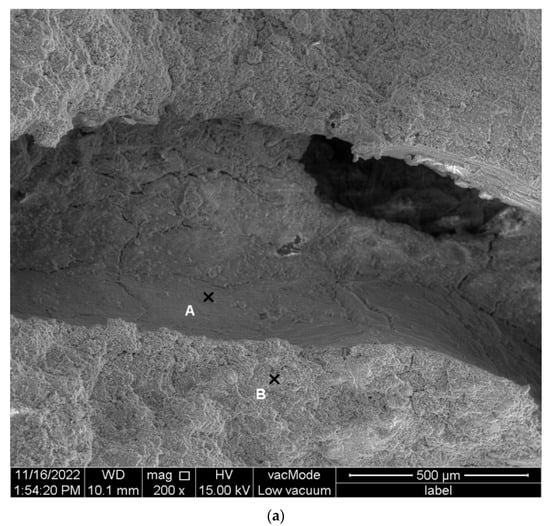
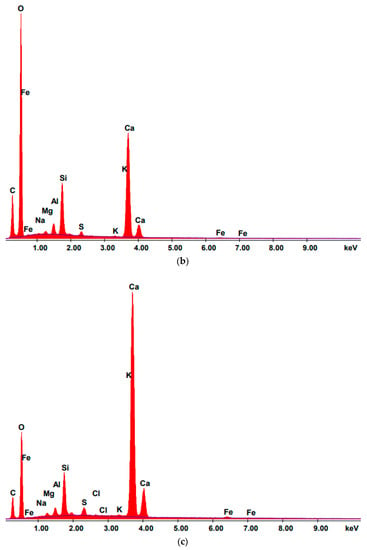
Figure 14.
Baseline sample (700 °C): (a) SEM photograph with points A and B marked; (b) the results of the EDS microanalysis of the sample point A; (c) the results of the EDS microanalysis of the sample point B.
In the SEM photographs, the cracks appeared only in the samples heated at 500 °C. Heating at a temperature of 700 °C causes greater degradation of the samples and an increase in the opening of cracks. The obtained results confirm the known patterns of concrete destruction, in which the process of degradation of its structure begins at a temperature of over 200 °C.
Below are the photographs taken with a scanning microscope showing the points where the EDS analyses of the tested samples were carried out. Analyses were performed at two points on each sample. The first point was where the fiber was previously located, and the second point was the binder. The following figures are EDS microanalyses of the points marked in the photograph.
Table 5 presents the results of the EDS analyses, i.e., the oxide compositions of four concrete samples. The results were limited to four main components: CaO, SiO2, Al2O5 and Fe2O3.

Table 5.
Oxide compositions of four samples (measurement points: fiber site and binder).
The obtained result of the EDS analyses (oxide compositions) are characterized by a large dispersion of the obtained values. Based on these, it is difficult to determine whether we are dealing with dehydroxylation of portlandite (decrease in the amount of calcium hydroxide in the cement matrix), this process takes place at a temperature of about 500 °C. The effect of the temperature in the range of 600–700 °C, resulting in, among other things, the decomposition of calcium carbonate with a simultaneous increase in the volume of calcium compounds, which causes concrete cracking and a significant decrease in its strength, is not shown.
4. Conclusions
The analysis of the obtained results of the experiments allowed the formulation of the following conclusions:
- The tests of fresh cement mortar showed that the introduction of PPF fibers had a significant effect on consistency. However, much smaller differences occur in the density of the mixture. The results in this area are varied and depend on the type, length and shape of the fibres.
- In all cases tested as part of the strength tests, the samples after 56 days of maturation obtained higher strength. These differences were particularly large for type I fiber and amounted to about 80% for bending strength and 13% for compression in relation to tests carried out after 28 days of maturation.
- It has been shown that the shape and type of PPF fibers have a significant impact on strength at normal temperatures of 20 °C. Type I fibers have the highest strength (higher than reference samples) and type III fibers have the lowest strength. These differences are quite significant.
- Similar to I, during the tests at elevated temperatures, the highest residual strength was shown by type I fibers. Importantly, the addition of fibers of all types resulted in a decrease in the strength decrease both during compression and bending. In general, it can be stated that the addition of PPF fibers has a positive effect on the residual strength of mortars.
- Spalling of samples with PPF fibers was not observed during annealing. This confirms the previous results of studies widely described in the literature.
- The obtained results of the EDS analyses (oxide compositions) are characterized by a large dispersion of the obtained values. It is difficult to clearly indicate the effect of high temperatures on the formation of mortar cracking.
Author Contributions
Conceptualization, G.R., A.P. and P.O.; methodology, G.R., A.P. and P.O.; software, A.P.; validation, A.P., J.S., K.W. and G.R.; formal analysis, A.P. and P.H.; investigation, A.P. and M.Ż.; resources, P.O.; data curation, G.R., A.P. and P.O.; writing—original draft preparation, G.R., A.P., J.S. and P.O.; writing—review and editing, G.R., A.P. and P.O.; visualization, A.P. and G.R.; supervision, G.R.; project administration, A.P. and M.Ż.; funding acquisition, G.R. and P.O. All authors have read and agreed to the published version of the manuscript.
Funding
This research received no external funding.
Data Availability Statement
The data presented in the study are publicly available at the Institute of Civil Engineering, Warsaw University of Life Sciences, 166 Nowoursynowska Street, 02-787 Warsaw, Poland.
Conflicts of Interest
The authors declare no conflict of interest.
References
- European Environment Agency. EEA-Eionet Strategy 2021–2030; European Environment Agency: Copenhagen, Denmark, 2021. [Google Scholar]
- Banthia, N.; Zanotti, C.; Sappakittipakorn, M. Sustainable fiber reinforced concrete for repair applications. Constr. Build. Mater. 2014, 67, 405–412. [Google Scholar] [CrossRef]
- Kulesza, M.; Dębski, D.; Fangrat, J.; Michalak, J. Effect of redispersible polymer powders on selected mechanical properties of thin-bed cementitious mortars. Cem. Wapno Beton 2020, 2020, 168–177. [Google Scholar] [CrossRef]
- Liu, F.; Ding, W.; Qiao, Y. An experimental investigation on the integral waterproofing capacity of polypropylene fiber concrete with fly ash and slag powder. Constr. Build. Mater. 2019, 212, 675–686. [Google Scholar] [CrossRef]
- Sabet, F.A.; Libre, N.A.; Shekarchi, M. Mechanical and durability properties of self consolidating high performance concrete incorporating natural zeolite, silica fume and fly ash. Constr. Build. Mater. 2013, 44, 175–184. [Google Scholar] [CrossRef]
- Rudnicki, T.; Wołoszka, P. The use of technology whitetopping in the aspect of implementation of repairs of flexible pavements. Bull. Mil. Univ. Technol. 2016, 65, 3. [Google Scholar] [CrossRef]
- Limbachiya, M.; Meddah, M.S.; Ouchagour, Y. Use of recycled concrete aggregate in fly-ash concrete. Constr. Build. Mater. 2012, 27, 439–449. [Google Scholar] [CrossRef]
- Klimek, B.; Szulej, J.; Ogrodnik, P. The effect of replacing sand with aggregate from sanitary ceramic waste on the durability of stucco mortars. Clean Technol. Environ. Policy 2020, 22, 1929–1941. [Google Scholar] [CrossRef]
- Kadela, M.; Kukiełka, A. Influence of foaming agent content in fresh concrete on elasticity modulus of hard foam concrete. In Brittle Matrix Composites 11, Proceedings of the 11th International Symposium on Brittle Matrix Composites BMC 2015, Warsaw, Poland, 28–30 September 2015; Institute of Fundamental Technological Research PAS: Warsaw, Poland, 2015; pp. 489–496. [Google Scholar]
- Rudnicki, T.; Jurczak, R. Recycling of a Concrete Pavement after over 80 Years in Service. Materials 2020, 13, 2262. [Google Scholar] [CrossRef]
- Osborne, G.J. Durability of Portland blast-furnace slag cement concrete. Cem. Concr. Compos. 1999, 21, 11–21. [Google Scholar] [CrossRef]
- De Domenico, D.; Faleschini, F.; Pellegrino, C.; Ricciardi, G. Structural behavior of RC beams containing EAF slag as recycled aggregate: Numerical versus experimental results. Constr. Build. Mater. 2018, 171, 321–337. [Google Scholar] [CrossRef]
- Ogrodnik, P.; Zegardło, B.; Radzikowska, M. Use of post-production sanitary ceramic waste as a filler in cement composites of high chemical resistance. Przem. Chem. 2017, 96, 1100–1104. [Google Scholar] [CrossRef]
- Gesoglu, M.; Güneyisi, E.; Hansu, O.; Etli, S.; Alhassan, M. Mechanical and fracture characteristics of self-compacting concretes containing different percentage of plastic waste powder. Constr. Build. Mater. 2017, 140, 562–569. [Google Scholar] [CrossRef]
- Asokan, P.; Osmani, M.; Price, A.D.F. Improvement of the mechanical properties of glass fibre reinforced plastic waste powder filled concrete. Constr. Build. Mater. 2010, 24, 448–460. [Google Scholar] [CrossRef]
- Jackowski, M.; Małek, M.; Życiński, W.; Łasica, W.; Owczarek, M. Characterization of new recycled polymers shots addition for the mechanical strength of concrete. Mater. Tehnol. 2020, 54, 355–358. [Google Scholar] [CrossRef]
- Hama, S.M.; Hilal, N.N. Fresh properties of self-compacting concrete with plastic waste as partial replacement of sand. Int. J. Sustain. Built Environ. 2017, 6, 299–308. [Google Scholar] [CrossRef]
- Choi, Y.W.; Moon, D.J.; Chumg, J.S.; Cho, S.K. Effects of waste PET bottles aggregate on the properties of concrete. Cem. Concr. Compos. 2005, 35, 776–781. [Google Scholar] [CrossRef]
- Yin, S.; Tuladhar, R.; Shi, F.; Combe, M.; Collister, T.; Sivakugan, N. Use of macro plastic fibers in concrete: A review. Constr. Build. Mater. 2015, 93, 180–188. [Google Scholar] [CrossRef]
- Kim, S.B.; Yi, N.H.; Kim, H.Y.; Kim, J.H.J.; Song, Y.C. Material and structural performance evaluation of recycled PET fiber reinforced concrete. Cem. Concr. Res. 2010, 32, 232–240. [Google Scholar] [CrossRef]
- Szcześniak, A.; Stolarski, A. Dynamic Relaxation Method for Load Capacity Analysis of Reinforced Concrete Elements. Appl. Sci. 2018, 8, 396. [Google Scholar] [CrossRef]
- Jiang, C.; Huang, S.; Zhu, Y.; Lin, Y.; Chen, D. Effect of polypropylene and basalt fiber on the behavior of mortars for repair applications. Adv. Mater. Sci. Eng. 2016, 2016, 14–16. [Google Scholar] [CrossRef]
- Padalu, P.K.V.R.; Singh, Y.; Das, S. Efficacy of basalt fibre reinforced cement mortar composite for out-of-plane strengthening of unreinforced masonry. Constr. Build. Mater. 2018, 191, 1172–1190. [Google Scholar] [CrossRef]
- Lignola, G.P.; Caggegi, C.; Ceroni, F.; de Santis, S.; Krajewski, P.; Lourenço, P.B.; Morganti, M.; Papanicolaou, C.; Pellegrino, C.; Prota, A.; et al. Performance assessment of basalt FRCM for retrofit applications on masonry. Compos. Part B Eng. 2017, 128, 1–18. [Google Scholar] [CrossRef]
- Simoes, T.; Costa, H.; Dias-da-Costa, D.; Júlio, E. Influence of type and dosage of micro-fibres on the physical properties of fibre reinforced mortar matrixes. Constr. Build. Mater. 2018, 187, 1277–1285. [Google Scholar] [CrossRef]
- Li, L.G.; Zhuo, H.X.; Zhu, J.; Kwan, A.K.H. Packing density of mortar containing polypropylene, carbon or basalt fibres under dry and wet conditions. Powder Technol. 2019, 342, 433–440. [Google Scholar] [CrossRef]
- Barnat-Hunek, D.; Łagód, G.; Fic, S.; Jarosz-Hadam, M. Effect of polysiloxanes on roughness and durability of basalt fibres-reinforced cement mortar. Polymers 2018, 10, 420. [Google Scholar] [CrossRef] [PubMed]
- Atiyeh, M.; Aydin, E. Carbon-Fiber Enriched Cement-Based Composites for Better Sustainability. Materials 2020, 13, 1899. [Google Scholar] [CrossRef] [PubMed]
- Song, P.S.; Hwang, S.; Sheu, B.C. Strength properties of nylon- and polypropylene fibre reinforced concretes. Cem. Concr. Res. 2005, 35, 1546–1550. [Google Scholar] [CrossRef]
- Nili, M.; Afroughsabet, V. The effects of silica fume and polypropylene fibres on the impact resistance and mechanical properties of concrete. Constr. Build. Mater. 2010, 24, 927–933. [Google Scholar] [CrossRef]
- Karahan, O.; Atis, C.D. The durability properties of polypropylene fiber reinforced fly ash concrete. Mater. Des. 2011, 32, 1044–1049. [Google Scholar] [CrossRef]
- Habib, A.; Begum, R.; Alam, M.M. Mechanical Properties of Synthetic Fibers Reinforced Mortars. Int. J. Sci. Eng.Res. 2013, 4, 923–927, ISSN 2229-5518. [Google Scholar]
- Ponikiewski, T.; Szwabowski, J. Influence of the Type of Fibers on the Workability of Mortars; Publishing House of the Cracow University of Technology: Krakow, Poland, 2003; pp. 364–371. [Google Scholar]
- Ezerskiy, V.; Lelusz, M. Influence of anti-frost admixtures and cement class on the strength of cement mortars. Civ. Environ. Eng. 2010, 1, 111–116. [Google Scholar] [CrossRef]
- Drzymała, T.; Zegardło, T.; Jackiewicz-Rek, W.; Sowiński, D. The Effect of High Temperatures on the Flexural Strength of Cement Mortar Modified by the Addition of Polypropylene Fibres. Saf. Fire Technol. 2018, 51, 26–39. [Google Scholar] [CrossRef]
- EN-197-1:2011; Cement—Part 1: Composition, Requirements and Conformity Criteria for Common Cements. BSI: London, UK, 2011.
- PN-B-19707:2023-05; Cement—Special Cement—Composition, Requirements and Compliance Criteria. PKN: Warszawa, Polska, 2023.
- EN 196-1:2016-07; Cement Test Methods—Part 1: Determination of Strength. BSI: London, UK, 2016.
- Parameters of Pure Cement CEM I 42.5 R. Available online: https://ozarow.com.pl/p-cem-i-42-5-r-luz-cement-czysty (accessed on 8 August 2023).
- Size Distribution of Standard Sand Grains. Available online: https://kwarcmix.pl/ (accessed on 7 August 2023).
- EN 14889-2:2007; Concrete Fibers—Part 2: Polymer Fibers—Definitions, Requirements and Compliance. BSI: London, UK, 2007.
- Data from the Fiber Manufacturer. Available online: https://wigolen.com.pl/kategoria/wlokna-polipropylenowe/ (accessed on 7 August 2023).
- EN 1015-3:2000; Test Methods for Mortars for Masonry—Determination of the Consistency of Fresh Mortar (Using Flow Table). BSI: London, UK, 2000.
- EN 1015-6:2000; Test Methods for Mortars for Masonry—Determination of Bulk Density of Fresh Mortar. BSI: London, UK, 2000.
- Powęzka, A.; Ogrodnik, P.; Szulej, J.; Pecio, M. Glass cullet as additive to new sustainable composites based on alumina binder. Energies 2021, 14, 3423. [Google Scholar] [CrossRef]
- EN 1363-1:2020-07; Fire Resistance Tests—Part 1: General Requirements. BSI: London, UK, 2020.
- Powęzka, A.; Szulej, J.; Ogrodnik, P. Reuse of Heat Resistant Glass Cullet in Cement Composites Subjected to Thermal Load. Materials 2020, 13, 4434. [Google Scholar] [CrossRef] [PubMed]
- Win, T.T.; Jongvivatsakul, P.; Jirawattanasomkul, T.; Prasittisopin, L.; Likitlersuang, S. Use of polypropylene fibers extracted from recycled surgical face masks in cement mortar. Constr. Build. Mater. 2023, 391, 131845. [Google Scholar] [CrossRef]
- Chen, H.; Huang, X.; He, R.; Zhou, Z.; Fu, C.; Wang, J. Mechanical properties of polypropylene fiber cement mortar under different loading speeds. Sustainability 2021, 13, 3697. [Google Scholar] [CrossRef]
- Feng, H.; Gao, D.Y.; Yuan, J. The mechanical properties of polypropylene fiber reinforced polymer modified cement mortar. Appl. Mech. Mater. 2013, 438–439, 283–289. [Google Scholar] [CrossRef]
- Ogrodnik, P.; Szulej, J. The impact of aeration of concrete based on ceramic aggregate, exposed to high temperatures, on its strength parameters. Constr. Build. Mater. 2017, 157, 909–916. [Google Scholar] [CrossRef]
- Jean-Christophe Mindeguia Pierre Pimienta Albert Noumowé Mulumba Kanema Temperature, pore pressure and mass variation of concrete subjected to high temperature—Experimental and numerical discussion on spalling risk. Cem. Concr. Res. 2010, 40, 477–487. [CrossRef]
- Kalifa, P.; Chene, G.; Galle, C. High-temperature behaviour of HPC with polypropylene fibres: From spalling to microstructure. Cem. Concr. Res. 2001, 31, 1487–1499. [Google Scholar] [CrossRef]
- Nuaklong, P.; Boonchoo, N.; Jongvivatsakul, P.; Charinpanitkul, T. Hybrid effect of carbon nanotubes and polypropylene fibers on mechanical properties and fire resistance of cement mortar. Constr. Build. Mater. 2021, 275, 122189. [Google Scholar] [CrossRef]
- Boqiao, Y.Y.; Zhuge, W.Y.; Zhuge, Y.; Huang, Z. Properties of hybrid basalt-polypropylene fiber reinforced mortar at different temperatures. Constr. Build. Mater. 2022, 346, 128433. [Google Scholar] [CrossRef]
Disclaimer/Publisher’s Note: The statements, opinions and data contained in all publications are solely those of the individual author(s) and contributor(s) and not of MDPI and/or the editor(s). MDPI and/or the editor(s) disclaim responsibility for any injury to people or property resulting from any ideas, methods, instructions or products referred to in the content. |
© 2023 by the authors. Licensee MDPI, Basel, Switzerland. This article is an open access article distributed under the terms and conditions of the Creative Commons Attribution (CC BY) license (https://creativecommons.org/licenses/by/4.0/).